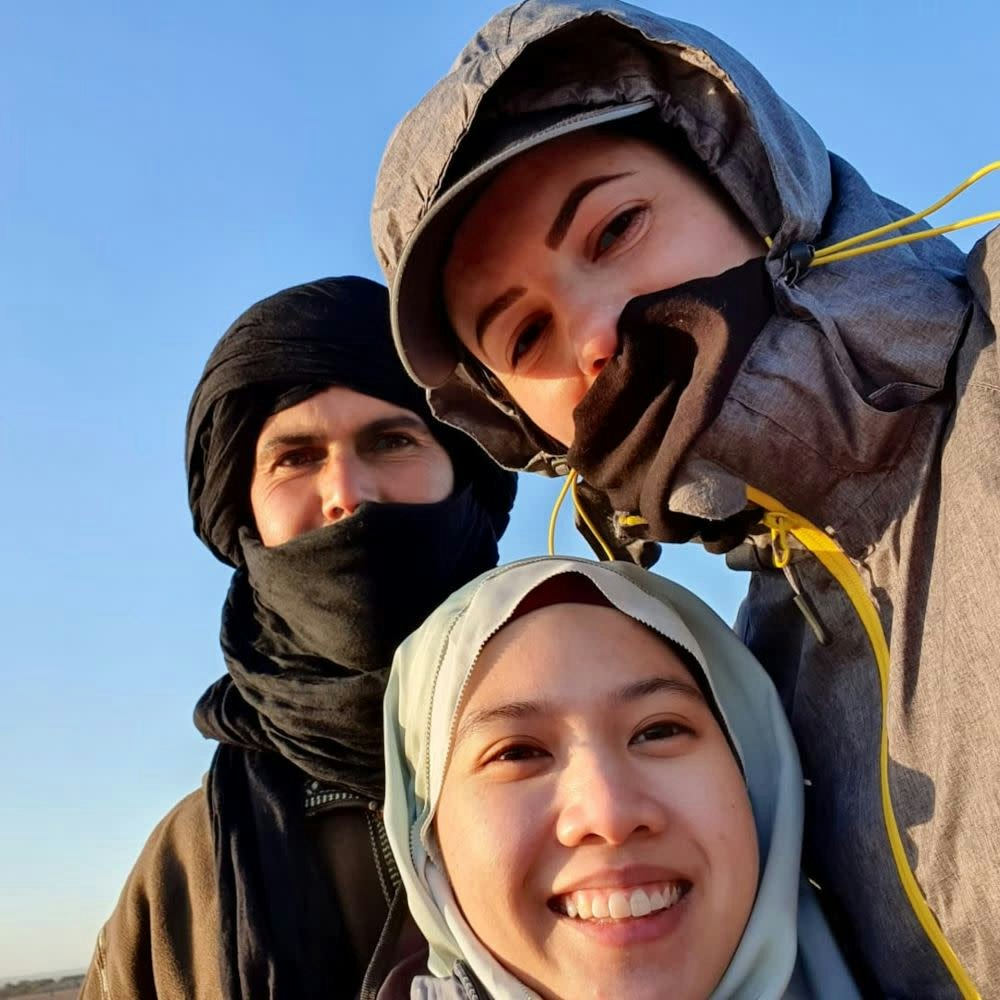The Adventurer's Wardrobe: What To Wear In The Sahara Desert, Morocco
Fancy summitting Northern Africa's highest peak in the same trip? Check out our Mt. Toubkal and Sahara Desert Adventure
What to Wear in the Sahara Desert: Why Dressing Right Matters

Types of Clothing Material Suitable for the Desert

Cotton- 'Yay' or 'Nay'?
Synthetic Materials
Breathability and Moisture-Wicking Properties
Essential Clothing Items for Men and Women

Clothing Items for Men

Loose-fitting pants or trousers: When it comes to pants, think utility over style. Breathable materials like a cotton-synthetic blend offer the best of both worlds: comfort and quick-drying properties. Zip-off pants that convert into shorts can be a versatile option.
Long-sleeve, loose-fitting tops: Sunburn is a genuine concern in the Sahara. Opt for tops that are breathable and offer sun protection. Materials with a UPF (Ultraviolet Protection Factor) rating are a good choice.
Briefs: Trust us, you don't want to be adjusting your underwear while riding a camel. Briefs offer better support and are generally more comfortable for activities that require a lot of sitting or movement.
Wide-brimmed hat: A hat with a wide brim provides essential protection from the sun and helps to reduce the risk of heatstroke. Some hats come with a neck flap for added protection.
Sunglasses: The glare from the sun can be intense in the desert. Polarized lenses are a must for reducing glare and protecting your eyes.
Scarf or bandana: A lightweight scarf or bandana is not just a fashion statement. It helps cover your face in case of sandstorms and can also be soaked in water and wrapped around your neck to help keep you cool.
Sturdy shoes: The terrain in the Sahara can be uneven and rocky. Closed-toe hiking boots or shoes with good tread are ideal for walking on such surfaces. Make sure they're broken in before your trip to avoid blisters.
Clothing Items for Women

Loose-fitting pants or trousers: This is not the time for skinny jeans. Opt for pants made from breathable and moisture-wicking materials. Consider styles with pockets for added utility.
Long-sleeve, loose-fitting tops: Layering is your friend in the desert. Choose tops made from breathable fabrics that can be easily layered for fluctuating temperatures. Tops with a UPF rating are a bonus for added sun protection.
Briefs: Comfort is king, or in this case, queen. Choose briefs made from moisture-wicking material to avoid chafing during long walks or camel rides.
Wide-brimmed hat or scarf: A wide-brimmed hat provides excellent sun protection, but a stylish scarf can also do the trick. Some women prefer scarves, which can be easily adjusted and used for different purposes.
Sunglasses: The desert sun doesn't discriminate. Polarized lenses are essential for reducing glare and protecting your eyes.
Lightweight scarf: A light scarf can serve multiple purposes. It can be used for added sun protection, as a makeshift face cover, or as a mat to sit on during breaks.
Comfortable footwear: Closed-toe sandals or light hiking boots are ideal for the varied terrain you'll encounter. Ensure they're well-fitted and broken in before your trip to minimize the risk of blisters.
Packing Tips: Additional Items to Consider

Water bottle: Hydration is critical. Opt for an insulated bottle to keep your water cool.
Snacks: Pack non-perishable snacks like nuts or energy bars for quick energy boosts.
First aid kit: Include basics like band-aids, antiseptic wipes, and personal medication.
Camera and power bank: You'll want to capture the breathtaking landscapes. Remember your camera and a power bank to keep it charged.
Flashlight or headlamp: Useful for navigating your campsite at night in the Sahara desert of Morocco.
Toiletries: Travel-sized toiletries like toothpaste, toothbrushes, and face wipes can be helpful.
Sunscreen and lip balm: The desert sun is harsh, so high SPF sunscreen and lip balm with sun protection are must-haves.
Hand sanitiser: Always a good idea, especially when you're far from running water.
Travel towel: Opt for a quick-drying microfiber towel.
Spare clothes: Pack an extra set of underwear and socks. You'll thank yourself later.
Conclusion
Find your next adventure
Why Skyhook?
Join over 27,000 Skyhook adventurers who've used our platform to book directly with our vetted local guides, at local prices (we never markup).
Expert Local Guides
Experienced local guides, handpicked by us.
Best Prices
Never pay a markup on the local guide's price.
Exclusive Club
Earn loyalty rewards every time you travel.
Great Social Vibes
Small group tours provide a richer experience.
Stellar Feedback
Over 3,000 reviews, average of 4.9/5 stars.








